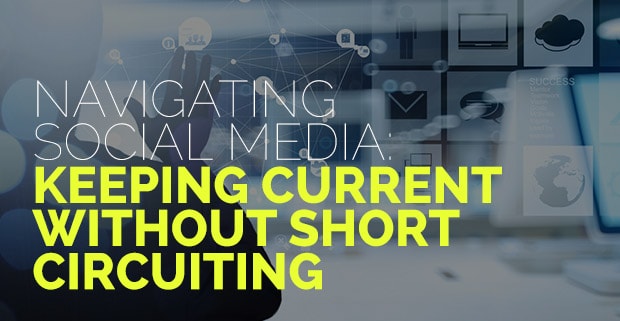 Image from Shutterstock.
Image from Shutterstock.
In a world where communication is instant, public, and permanent you need to be deliberate and strategic where you invest your time and develop your profile. Dayton English examines the titans, disruptors, and the niche social platforms and how to stay current on their use and benefit.
We’re at a point where technology offers numerous efficient (and addictive!) means of communication. As of 2014 we spent an average of nearly 2 hours per day on social media. It’s no wonder people are experiencing social media fatigue and some are even exiling themselves from social media all together.
The digital landscape is dotted with a social network for just about anything and anyone. From ultra-exclusive social networks that admit only certain users and cost $5,000 annually, to networks for people who love to knit (think Pinterest for knitting) there is a network for nearly anything.
Keeping it Professional
Likely the first website that comes to mind for professional social media presence is LinkedIn. And for good reason, with over 450 million members, 12 million of those in Canada. LinkedIn improves your ability to keep in contact with former classmates and colleagues, follow companies and join groups for any professional interest or topic.
For managing your professional network LinkedIn really fits most needs, but there are other sites that are targeted to specific audiences that you may want to consider. Angel.co is a great source for early stage start-ups. Follow and connect with start-ups and their founders, see job postings and connect with other people.
There are some smaller social networks as well, such as Opportunity. These sites have smaller membership bases, but if you identify your target professional audience is disproportionately on one of these sites you’d be effective at cutting through the noise of larger sites and directing your effort there.
Friends with Benefits
This is social media sites that are dual purpose. You can tell your friends about the last movie you saw, but there is significant professional potential as well. Twitter is top of the list and owns this space. Many companies feature job postings on Twitter and it is socially acceptable to tweet up senior leaders with your dream employer.
Creating a list of companies and job boards that are of interest is an efficient way to stay on top of opportunities in your field.
You may also connect with colleagues and friends on Twitter, just be mindful that current or desired employers can also see what you post on this site, unless you lock your profile down, which limits the site’s potential.
With that said, you’re best to be cautious with how you manage your content on any social website. It’s probably best to not post that party pic or rant about controversial topics.
Sharing Pictures of Cats
The giant of all social platforms, Facebook, dominates this space. With 1.71 billion active monthly users Facebook controls digital activity like no other platform. Membership numbers are slightly inflated, if you’ve ever spent time on their site you’ve no doubt received spam friend requests.
You should also maintain an awareness of the changing landscape and new resources, so you’re continuously at the top of your game.
Facebook estimated as many as 11% of their accounts in 2013 were fake. Nevertheless their influence is undeniable in terms of the size of their audience and as industry leaders.
There is some professional benefit to Facebook. Companies have pages on there and often are more open than on LinkedIn. Customer reviews, photos of the latest team building event, or evidence of how they’re carrying out their mission can be found on Facebook. The day to day life of an organization might be more obvious to learn about than by reading the ‘About Us’ page on their website or LinkedIn page.
Keeping up with the Joneses
Rather than trying to achieve arbitrary thresholds of social metric success in your personal profile, such as number of followers or posts, it is better to control your space. What that means is keeping aware of your personal and professional needs, and focusing your professional and professional time on the resources that’ll best meet those goals.
If you’re on a site it is important to have some level of engagement, but you don’t have to be a hyper engaged creator of content. While you don’t want your Twitter feed to be a ghost town it is perfectly acceptable to be more of an observer than spending inordinate amounts of time engaging with people or topics that have no lasting benefit to your needs.
You should also maintain an awareness of the changing landscape and new resources, so you’re continuously at the top of your game.
If you follow these steps you’ll find success and value in your digital effort, and avoid the fatigue.
Dayton has a background in marketing and communications and is passionate about the issues that influence professionals in his field. He obtained his Masters in Professional Communications from Royal Roads University.